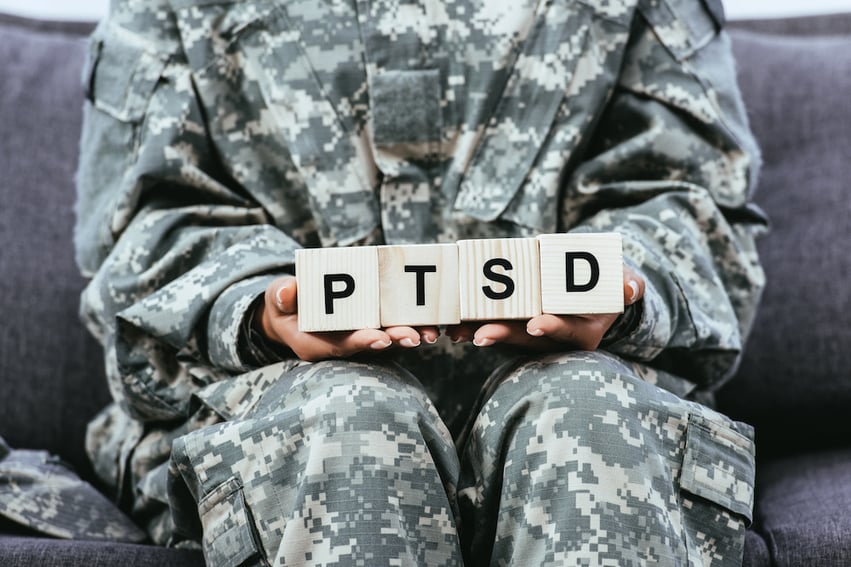Published on: February 25, 2020

Many people associate post-traumatic stress disorder (PTSD) with combat veterans; after all, it used to be known as “shell shock” and “combat fatigue.” While many veterans do suffer from PTSD, today we know that this psychiatric disorder can occur in people who have experienced or witnessed other traumatic events, such as a natural disaster, a serious accident, a terrorist act, rape or assault, and more. In fact, studies show that PTSD affects approximately 3.5% of American adults, and that an estimated one in 11 people will be diagnosed with PTSD in their lifetime. Before covering PTSD disability benefits, let’s take a look at the disorder’s symptoms and how it’s diagnosed.
.png?width=1000&height=600&name=MicrosoftTeams-image%20(203).png)
Symptoms and Diagnosis of PTSD
According to the American Psychiatric Association, symptoms of PTSD fall into four categories with specific symptoms varying in severity.
- Intrusive thoughts such as repeated, involuntary memories; distressing dreams; or vivid flashbacks that make people feel as if they are re-living the traumatic experience or seeing it before their eyes.
- Avoiding people, places, activities, objects, and situations that bring on distressing memories of the traumatic event.
- Having negative thoughts or distorted beliefs about oneself or others, such as “I am bad” or “No one can be trusted”; ongoing fear, anger, guilt or shame; much less interest in activities previously enjoyed; or feeling detached from others.
- Being irritable and having angry outbursts; acting recklessly or being self-destructive; or having problems concentrating or sleeping.
Symptoms of PTSD usually develop in the days following the traumatic event (a similar diagnosis, acute stress disorder, shows symptoms between three days and one month after the event). However, to be diagnosed with either, symptoms must last for more than a month and often persist for months and sometimes years.
For people with PTSD, the symptoms above and the chronic anxiety associated with it can cause significant problems functioning normally, interrupting their work and personal life. It can also lead to other related conditions, such as depression, substance use, memory problems, and other physical and mental health problems. For these reasons, people suffering from this disorder can often receive PTSD disability benefits.
Social Security Disability Requirements for PTSD
To receive PTSD disability benefits, your medical records must meet the requirements of the Social Security Administration’s Blue Book listing for anxiety-related disorders. The listing states that you must:
1. Demonstrate three or more of the following behaviors:
- Restlessness
- Easily fatigued
- Difficulty concentrating
- Irritability
- Muscle tension
- Sleep disturbance
2. Demonstrate extreme limitation of one, or marked limitation of two, of the following areas of mental functioning:
- Understanding, remembering or applying information
- Interacting with others
- Concentrating, persisting, or maintaining pace
- Adapting or managing oneself
Other ways to qualify under the anxiety listing are having the required symptoms of panic attacks (Disproportionate fear or anxiety about at least two different situations, for example, using public transportation, being in a crowd, being outside of your home, or being in open spaces) or obsessive-compulsive disorder (Involuntary, time-consuming preoccupation with intrusive, unwanted thoughts, or performing repetitive behaviors aimed at reducing anxiety).
If these don’t qualify you for PTSD disability benefits, the SSA examiner will also consider approving applications if the disorder is determined to be “serious and persistent.” This means you suffer from near-extreme anxiety or emotional disturbance (the occasional bad recollection does not count). To qualify, you must have two or more years of medically documented history of the disorder and that despite treatment, therapy, psychosocial support, and PTSD programs, you still have minimal capacity to adapt to changes in your environment or to demands that are not already part of your daily life.
There is one other path to approval, known as a "medical-vocational allowance," which is based upon PTSD and work limitations. While this may sound like it's an exception, it’s often how to get disability for PTSD. For consideration under a medical-vocational allowance, also known as your Residual Functional Capacity (RFC), the SSA claims examiner will have had to first determine that you cannot be awarded benefits on the basis of meeting the requirements under the SSA’s anxiety listing and that the condition is sufficiently severe as to prevent you from maintaining regular employment.
Advice For Seeking PTSD Disability in Florida
If you or a loved one suffers from post-traumatic stress disorder (PTSD), then you understand how devastating a condition it can be. However, psychological impairments such as anxiety, depression, and other conditions can be difficult to document in order to receive PTSD disability benefits. Records and letters from a psychologist or psychiatrist will benefit your application the most, but it can also be helpful for family members, friends, and former employers to record their observations; letters from those individuals can be persuasive when the SSA reviews your case. Finally, you might consider keeping your own personal journal of your challenges so that the reviewer can read about your daily struggles firsthand.
Suffering from PTSD? We’re Here For You
We’ve seen and understand the harsh effects of traumatic events, and we want to fight for you to get you the PTSD disability benefits you deserve. Once you’re more financially secure, you’ll be better able to take care of and perhaps even resolve your PTSD. If you or a loved one is suffering, contact the Disability Experts of Florida today for a free, no-obligation Florida PTSD case evaluation.

